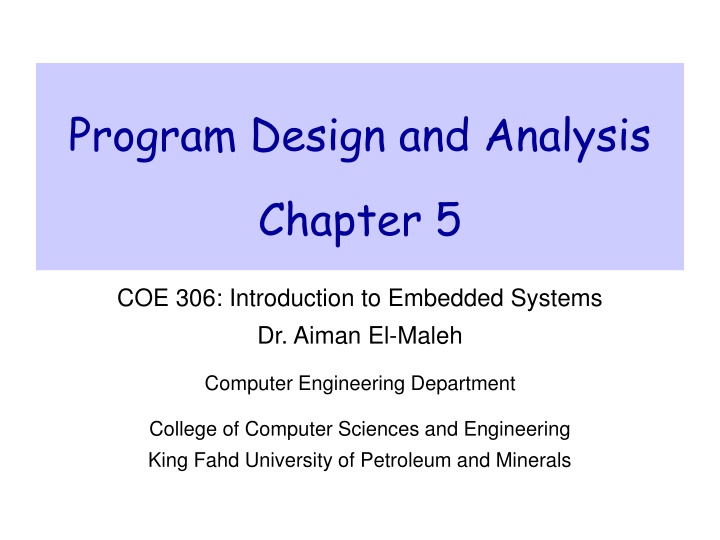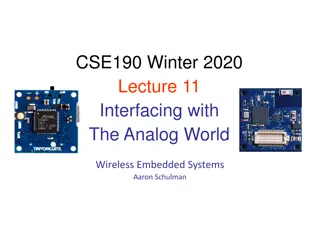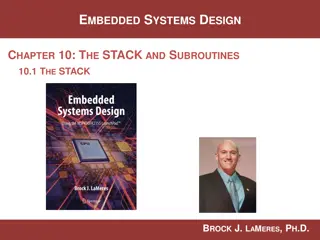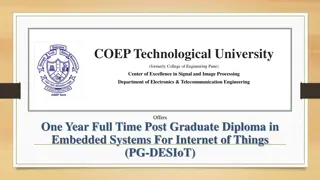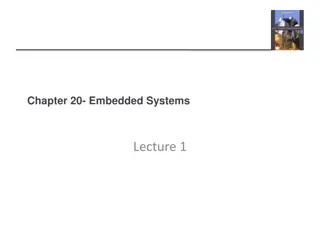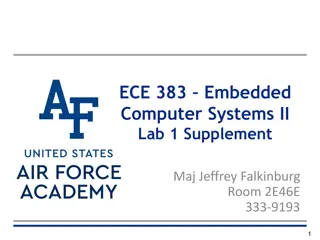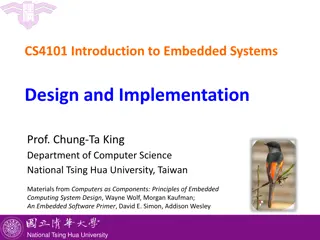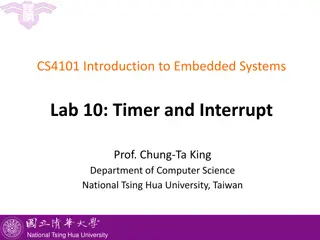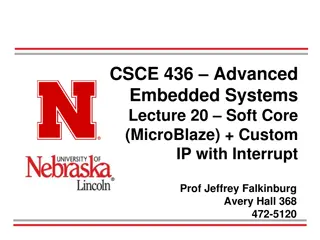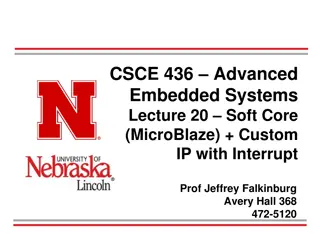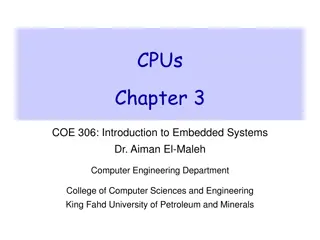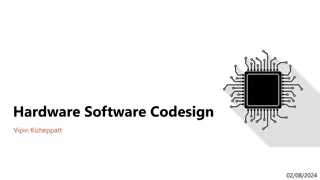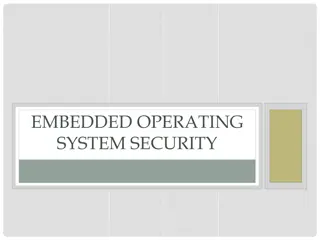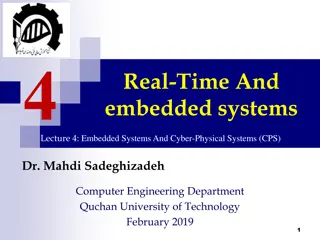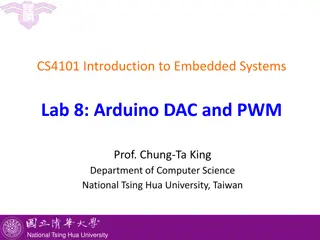Introduction to Embedded Systems and Software Components
Embedded systems play a crucial role in various applications, with components like state machines, circular buffers, and queues being essential. State machines help in maintaining system behavior, while circular buffers are useful in digital signal processing. The use of queues aids in managing tasks efficiently. Understanding these software components is vital for designing effective embedded systems.
Download Presentation

Please find below an Image/Link to download the presentation.
The content on the website is provided AS IS for your information and personal use only. It may not be sold, licensed, or shared on other websites without obtaining consent from the author.If you encounter any issues during the download, it is possible that the publisher has removed the file from their server.
You are allowed to download the files provided on this website for personal or commercial use, subject to the condition that they are used lawfully. All files are the property of their respective owners.
The content on the website is provided AS IS for your information and personal use only. It may not be sold, licensed, or shared on other websites without obtaining consent from the author.
E N D
Presentation Transcript
Program Design and Analysis Chapter 5 COE 306: Introduction to Embedded Systems Dr. Aiman El-Maleh Computer Engineering Department College of Computer Sciences and Engineering King Fahd University of Petroleum and Minerals
Next . . . Embedded Software Components State Machines Circular Buffers Queues Models of Programs The Compilation Process Compiler Optimizations Program Design and Analysis COE 306 Introduction to Embedded System KFUPM slide 2
Embedded Software Components Embedded code must run at a required rate to meet system deadlines, fit into the allowed amount of memory, meet power consumption requirements Some of the most common software components in embedded systems are: 1. State machines: well suited to reactive systems such as user interfaces 2. Circular buffers: useful in digital signal processing 3. Queues: useful in digital signal processing Program Design and Analysis COE 306 Introduction to Embedded System KFUPM slide 3
Software State Machine Finite State Machine (FSM) keeps internal state as a variable, changes state based on inputs Uses: control-dominated code; reactive systems FSM state diagrams can greatly reduce the chances of human error A way of describing and documenting desired behavior precisely and unambiguously Force you to understand your system behavior more clearly Using a state machine implementation, rather than hand-coded logic, can ensure the structure is implemented correctly Program Design and Analysis COE 306 Introduction to Embedded System KFUPM slide 4
State Machine Example: Seat Belt Controller Turn on buzzer if a person sits in a seat and does not fasten the seat belt within a fixed amount of time Inputs: Seat sensor: to know when a person has sat down Seat belt sensor: to know when the belt is fastened Timer: to know when the fixed interval has elapsed Output: the buzzer Program Design and Analysis COE 306 Introduction to Embedded System KFUPM slide 5
State Machine Example: Seat Belt Controller Program Design and Analysis COE 306 Introduction to Embedded System KFUPM slide 6
Seat Belt Controller: C Code #define IDLE 0 #define SEATED 1 #define BELTED 2 #define BUZZER 3 buzzer_on = OFF; timer_on = OFF; switch(state) { case IDLE: if (seat) { state = SEATED; timer_on = TRUE; } break; case SEATED: if (belt) state = BELTED; else if (!seat) {state = IDLE;} else if (timer) {state = BUZZER; buzzer_on = TRUE; } break; case BELTED: if (!belt) { state = SEATED; timer_on = TRUE; } break; case BUZZER: if (belt) {state = BELTED; buzzer_on = OFF;} else if (!seat) { state = IDLE; buzzer_on = OFF; } } Program Design and Analysis COE 306 Introduction to Embedded System KFUPM slide 7
State Machine Example: An Elevator System An elevator system of an N- Story building is composed of two units, a controller unit and a request resolver unit. The request resolver unit receives N buttons inside the elevator to indicate the desired floor. It also receives two buttons from each floor one for going up and another for going down requests. Program Design and Analysis COE 306 Introduction to Embedded System KFUPM slide 8
State Machine Example: An Elevator System In addition, it receives a floor input indicating the current floor level and the two signals up and down indicating the direction of movement of the elevator. The controller unit receives the requested floor from the request resolver unit and a floor input indicating the current floor level. It generates three control signals as outputs: up, down and open. The signals up and down control the direction of movement of the elevator while the open signals control the elevator door. The system will move the elevator either up or down to reach the requested floor. Program Design and Analysis COE 306 Introduction to Embedded System KFUPM slide 9
State Machine Example: An Elevator System Once at the requested floor, the elevator door is opened for at least 10 seconds, and is kept open until the requested floor changes. It must be ensured that the elevator door is never open while the elevator is moving. Program Design and Analysis COE 306 Introduction to Embedded System KFUPM slide 10
State Machine Example: An Elevator System #define IDLE 0 #define GOINGUP 1 #define GOINGDN 2 #define DOOROPEN 3 int timer=0; Timer0 match and MCR registers are LPC_TIM0->MR0 and LPC_TIM0->MCR int req=0, floor=0; int up, down, open, timer_start; For TC registers to start counting, the least significant bit of the Timer Control Register (LPC_TIM0->TCR) must be set To clear the MR0 interrupt flag, set the least significant bit in the Interrupt Register (LPC_TIM0->IR) voidTIMER0_IRQHandler() { timer=1; LPC_TIM0->IR |= 1; } Program Design and Analysis COE 306 Introduction to Embedded System KFUPM slide 11
State Machine Example: An Elevator System void UnitControl() { NVIC_EnableIRQ(1); int state = IDLE; while (1) { switch (state) { IDLE: up=0; down=0; open=1; timer_start=0; if (req==floor) {state = IDLE;} if (req > floor) {state = GOINGUP;} if (req < floor) {state = GOINGDN;} break; GOINGUP: up=1; down=0; open=0; timer_start=0; if (req > floor) {state = GOINGUP;} if (!(req>floor)) {state = DOOROPEN;} break; Program Design and Analysis COE 306 Introduction to Embedded System KFUPM slide 12
State Machine Example: An Elevator System GOINGDN: up=0; down=1; open=0; timer_start=0; if (req < floor) {state = GOINGDN;} if (!(req<floor)) {state = DOOROPEN;} break; DOOROPEN: up=0; down=0; open=1; if (timer_start==0){ timer=0; timer_start=1; LPC_TIM0->TCR |= 1; LPC_TIM0->MR0 = 250000000; // clk freq = 25 MHZ LPC_TIM0->MCR |= 5; } if (!timer) {state = DOOROPEN;} else {state = IDLE;} break; } // switch statement } // while } Program Design and Analysis COE 306 Introduction to Embedded System KFUPM slide 13
Couch Controller You are asked to work on a motorized couch, with drink holders and a built-in drink cooler and reclining seats that tilt up and down. You are asked to write an embedded program that controls the tilt motor using a microcontroller. There s an up button and a down button. When the person switches from down to up, or up to down, you have to wait 100 milliseconds so that the motor doesn t burn out (i.e., move the motor from up/down to off and then to down/up positions). Draw the state machine diagram for the motorized couch controller using a Moore model. Program Design and Analysis COE 306 Introduction to Embedded System KFUPM slide 14
Couch Controller Program Design and Analysis COE 306 Introduction to Embedded System KFUPM slide 15
Traffic Light Controller It is required to design an embedded system that controls the traffic lights at an intersection of main and side streets. It receives inputs from all four corners indicating pedestrians that want to cross. In absence of crossing requests, it should allow each direction 10 seconds of green light, followed by 2 seconds of yellow light while the other traffic light will be red light (i.e., for 12 seconds). In presence of crossing requests at or after 5 seconds, immediately proceed with yellow. Program Design and Analysis COE 306 Introduction to Embedded System KFUPM slide 16
Traffic Light Controller Two buttons, Cross1 and Cross2, are used to indicate request for crossing across the main and side streets respectively. A pair of Red, Yellow and Green leds will be used for the two traffic lights. Program Design and Analysis COE 306 Introduction to Embedded System KFUPM slide 17
Traffic Light Controller Assume that any change in the inputs Cross1 and Cross2 will cause interrupts to update their values. Timer0 and Timer1 will be used to implement the required timing requirements. Program Design and Analysis COE 306 Introduction to Embedded System KFUPM slide 18
Traffic Light Controller voidTIMER0_IRQHandler() { timer0=1; LPC_TIM0->IR |= 1; } #define GR 0 #define YR 1 #define RG 2 #define RY 3 int state=0; int Cross1=0, Cross2=0; int timer0=0; timer1=0; voidTIMER1_IRQHandler() { timer1=1; LPC_TIM1->IR |= 1; } voidEINT0_IRQHandler() { if (state==GR) Cross1=1; for (int j=0; j<1000000; j++); LPC_SC->EXTINT |= 1; } voidEINT1_IRQHandler() { if (state==RG) Cross2=1; for (int j=0; j<1000000; j++); LPC_SC->EXTINT |= 2; } Program Design and Analysis COE 306 Introduction to Embedded System KFUPM slide 19
Traffic Light Controller voidSetTimer0(uint32_t delayInSec) { LPC_TIM0->TCR = 0x02; /* reset timer */ LPC_TIM0->MR0 = delayInSec*2000 * (12500000 / 1000 - 1); LPC_TIM0->MCR = 0x05; /* stop timer on match and enable interrupt*/ LPC_TIM0->TCR = 0x01; /* start timer */ } voidSetTimer1(uint32_t delayInSec) { LPC_TIM1->TCR = 0x02; /* reset timer */ LPC_TIM1->MR0 = delayInSec*2000 * (12500000 / 1000 - 1); LPC_TIM1->MCR = 0x05; /* stop timer on match and enable interrupt*/ LPC_TIM1->TCR = 0x01; /* start timer */ } LPC_GPIO0->FIODIR |= 7<<7; // set pins 0.7, 0.8, 0.9 for GYR for Main St. LPC_GPIO0->FIODIR |= 7<<23; // set pins 0.23, 0.24, 0.25 for GYR for Side St. LPC_PINCON->PINSEL4 |= (1<<20); // using pin p2.10 for Cross1 LPC_PINCON->PINSEL4 |= (1<<22); // using pin p2.11 for Cross2 Program Design and Analysis COE 306 Introduction to Embedded System KFUPM slide 20
Traffic Light Controller LPC_SC->EXTMODE |= 3; LPC_SC->EXTPOLAR |= 3; NVIC_EnableIRQ(EINT0_IRQn); NVIC_EnableIRQ(EINT1_IRQn); NVIC_EnableIRQ(TIMER0_IRQn); NVIC_EnableIRQ(TIMER1_IRQn); Cross1=0; Cross2=0; LPC_TIM0->PR = 0x00; /* set prescaler to zero */ SetTimer0(10); timer0=0; LPC_TIM1->PR = 0x00; /* set prescaler to zero */ SetTimer1(5); timer1=0; Program Design and Analysis COE 306 Introduction to Embedded System KFUPM slide 21
Traffic Light Controller while(1) { LPC_GPIO0->FIOSET |= (1<<25); //GYR if (timer0 || (timer1 && Cross1)){ state = YR; Cross1=0; SetTimer0(2); timer0=0; } break; switch(state){ case GR: printf("state GR\n"); LPC_GPIO0->FIOSET |= (1<<7); LPC_GPIO0->FIOCLR |= (1<<8); LPC_GPIO0->FIOCLR |= (1<<9); //GYR LPC_GPIO0->FIOCLR |= (1<<23); LPC_GPIO0->FIOCLR |= (1<<24); Program Design and Analysis COE 306 Introduction to Embedded System KFUPM slide 22
Traffic Light Controller case YR: printf("state YR\n"); LPC_GPIO0->FIOCLR |= (1<<7); LPC_GPIO0->FIOSET |= (1<<8); LPC_GPIO0->FIOCLR |= (1<<9); //GYR LPC_GPIO0->FIOCLR |= (1<<23); LPC_GPIO0->FIOCLR |= (1<<24); LPC_GPIO0->FIOSET |= (1<<25); //GYR if (timer0){ state = RG; SetTimer0(10); timer0=0; SetTimer1(5); timer1=0; } break; . . . Program Design and Analysis COE 306 Introduction to Embedded System KFUPM slide 23
Circular Buffer A data structure that allows efficient stream processing Commonly used in signal processing: new data constantly arrives; each datum has a limited lifetime. Use a circular buffer to hold the data stream Data stream x1 x2 x3 x4 x5 x6 t1 t2 t3 Circular buffer x1 x5 x2 x6 x3 x7 x4 Program Design and Analysis COE 306 Introduction to Embedded System KFUPM slide 24
Circular Buffer: C Implementation Data structure put() void init() { for (int i = 0; i < SIZE; i++) buffer[i] = 0; pos = SIZE - 1; } init() get() #define SIZE 3 int buffer[SIZE]; int pos; void put(int value) { pos = (pos + 1) % SIZE; buffer[pos] = value; } /* get the ith value earlier from the circular buffer; zero being the newest value */ int get(int i) { int index = (pos - i); If (index >=0) return buffer[index]; else return buffer[SIZE+index]; } Program Design and Analysis COE 306 Introduction to Embedded System KFUPM slide 25
Using Circular Buffers: FIR Filter One output: for (i = 0; i < SIZE; i++) y += x[i] * b[i]; Processing as a stream using a circular buffer: int fir(int x) { int i, y; put(x); for (i = 0, y = 0; i < SIZE; i++) y += b[i] * get(i); return y; } Program Design and Analysis COE 306 Introduction to Embedded System KFUPM slide 26
Using Circular Buffers: IIR Filter int a[4] = {0, a1, a2, a3}; int b[4] = {b0, b1, b2, b3}; #define SIZE 3 int iir(int x) { int i, t, aside=0, bside=0, v0, y; for (i=0; i<SIZE; i++){ t = get(i); aside += -a[i+1] * t; bside += b[i+1] * t; } v0 = x + aside y = b[0] * v0 + bside; put(v0); // put the new value return y; } Program Design and Analysis COE 306 Introduction to Embedded System KFUPM slide 27
Queues Used when data arrival and departure or amount is unpredictable A queue is also referred to as an elastic buffer Circular buffer has a fixed number of data elements while a queue may have varying number of elements Queues can be implemented based on linked lists or arrays A linked list allows arbitrary sizes but requires dynamic memory allocation Program Design and Analysis COE 306 Introduction to Embedded System KFUPM slide 28
An Array-Based Queue #define SIZE 5 void queue_init() { head = 0; tail = 0; } int q[SIZE]; int head, tail; void enqueue(int value) { if ((tail+1) % SIZE == head) error("The queue is full"); q[tail] = value; tail = (tail+1) % SIZE; } int dequeue() { int value; if (head == tail) error("The queue is empty"); value = q[head]; head = (head+1) % SIZE; return value; } A counter could be used to determine whether queue is full or empty Program Design and Analysis COE 306 Introduction to Embedded System KFUPM slide 29
An Array-Based Queue void queue_init() { head = NULL; tail = head; } int dequeue() { int value; if (head == NULL) error("The queue is empty"); else if (head == tail){ value = q[head]; head = NULL; tail = head; return value; } else { value = q[head]; head = (head+1) % SIZE; return value; } } void enqueue(int value) { if(head == NULL){ head = 0; tail = head; q[tail] = value; } else if((tail+1)%SIZE==head) error("The queue is full"); else { tail = (tail+1) % SIZE; q[tail] = value; } } Program Design and Analysis COE 306 Introduction to Embedded System KFUPM slide 30
Producer/Consumer Systems Queues allow varying input and output rates Queues modify the flow of control in the system as well as store data Program Design and Analysis COE 306 Introduction to Embedded System KFUPM slide 31
Models of Programs Source code is not a good representation for programs: clumsy language-dependent Compilers derive intermediate representations to manipulate and optimize the program Abstraction allows easier analysis One general model describes all language-specific models Program Design and Analysis COE 306 Introduction to Embedded System KFUPM slide 32
Data Flow Graph (DFG) A data flow graph is a model of a program with no conditionals Describes the minimal ordering requirements on operations Single-Assignment Form: A variable appears only once on the left-hand side x = a + b; y = c - d; z = x * y; y = b + d; x = a + b; y = c - d; z = x * y; y1 = b + d; original basic block single assignment form Program Design and Analysis COE 306 Introduction to Embedded System KFUPM slide 33
Data Flow Graph (DFG) x = a + b; y = c - d; z = x * y; y1 = b + d; single assignment form The data flow graph determines feasible reorderings of operations, which may help reduce pipeline or cache conflicts Program Design and Analysis COE 306 Introduction to Embedded System KFUPM slide 34
Control-Data Flow Graph (CDFG) CDFG: represents control and data Uses data flow graphs as components A CDFG has two types of nodes: Data flow nodes: encapsulates a complete data flow graph Write operations in basic block form for simplicity Decision nodes: describe all types of control (branch) Program Design and Analysis COE 306 Introduction to Embedded System KFUPM slide 35
CDFG Example if (cond1) bb1(); else bb2(); bb3(); switch (test1) { case c1: bb4(); break; case c2: bb5(); break; case c3: bb6(); break; } Program Design and Analysis COE 306 Introduction to Embedded System KFUPM slide 36
CDFG: For Loop For Loop: for (i=0; i<N; i++) loop_body(); Equivalent While Loop: i=0; while (i<N) { loop_body(); i++; } Program Design and Analysis COE 306 Introduction to Embedded System KFUPM slide 37
Compilation and Execution an image of the program s bits in memory Program Design and Analysis COE 306 Introduction to Embedded System KFUPM slide 38
From Assembly Code to Execution Assembly Code Human-readable Abstracts out instruction format Abstracts out exact addresses The Assembler Translates assembly code to binary representation (object code) according to instruction formats Partially translates labels into addresses The Linker Determines all addresses across multiple program files Generates the executable binary file Program Design and Analysis COE 306 Introduction to Embedded System KFUPM slide 39
The Assembler Labels are the most important abstraction provided by the assembler Label processing requires two passes: 1. Determine label addresses By advancing a Program Location Counter (PLC) PLC is incremented by instruction size (4 bytes in ARM) 2. Assemble instructions using computed label values The ORG pseudo-op specifies the origin, i.e., first address of the program Relocatable code requires alternative mechanisms both in assembly code and generated object code Program Design and Analysis COE 306 Introduction to Embedded System KFUPM slide 40
The Symbol Table Label addresses, resulting from the first pass, are recorded in a symbol table A pseudo-op allows adding symbols to the table without occupying space in program memory: EQU does not advance PLC Example: Program Design and Analysis COE 306 Introduction to Embedded System KFUPM slide 41
Object File Header location of main entry point (if any) size and position of pieces of file Text Segment: instructions Data Segment static data (local/global vars, strings, constants) Relocation Information Instructions and data that depend on actual addresses Linker patches these bits after relocating segments Symbol Table External (exported) references Unresolved (imported) references Program Design and Analysis COE 306 Introduction to Embedded System KFUPM slide 42
Object File Formats Unix a.out COFF: Common Object File Format ELF: Executable and Linking Format Windows PE: Portable Executable All support both executable and object files Program Design and Analysis COE 306 Introduction to Embedded System KFUPM slide 43
Linking Combines several object modules into a single executable module Allows programs to be divided into multiple files Allows using pre-assembled libraries Puts modules in order Modifies object code to make the necessary links between files Relocate each object s text and data segments Resolve as-yet-unresolved symbols Record top-level entry point in executable file Program Design and Analysis COE 306 Introduction to Embedded System KFUPM slide 44
The Linker The linker proceeds in two phases: 1. Determine the first address in each object file, based on: The order in which the files are to be loaded The size of each object file 2. Merge symbol tables, and update relative addresses in object files The assembler must identify label references in object files Both absolute and relative addressing are important in embedded systems Interrupts and I/O registers require absolute addressing Program Design and Analysis COE 306 Introduction to Embedded System KFUPM slide 45
Example Program Design and Analysis COE 306 Introduction to Embedded System KFUPM slide 46
Example Program Design and Analysis COE 306 Introduction to Embedded System KFUPM slide 47
Example: Objdump Disassembly Program Design and Analysis COE 306 Introduction to Embedded System KFUPM slide 48
Example: Objdump Symbols Program Design and Analysis COE 306 Introduction to Embedded System KFUPM slide 49
Linking Example Program Design and Analysis COE 306 Introduction to Embedded System KFUPM slide 50
